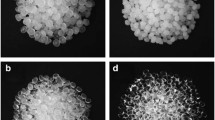Abstract
The search for new elastomeric materials with a service capability over a wide temperature range and for improved fire-resistant materials formed the basis for the Army interest in polyphosphazenes. The Army Watertown phosphazene program established important working relationships with government and industrial interests, and leading academic scientists. The Watertown laboratory, along with the Army Research Office, supported not only the fundamental research exploring the synthesis and properties of this new class of inorganic polymers, but also the development of polyphosphazenes and phosphazene fluids for the Army, Navy, other government, and commercial applications.
Similar content being viewed by others
References
Allcock H. R., Kugel R. L. (1965) J. Am. Chem. Soc. 87:4216
Allcock H. R., Kugel R. L., Valan K. J. (1966). Inorg. Chem. 5: 1709
S. H. Rose, J. Polym. Sci., B, 6 (1968)
A. Wilson, Initial Compounding Studies of Polyphosphazene Rubber, U.S. Army Natick Laboratories, Natick, MA 01760 TR 70-10-CE (C&PSEL-68) AD860170 (August 1969)
S. H. Rose and J. Cable, Synthesis of New Low Temperature Petroleum Resistant Elastomers (Horizons, Inc, Cleveland, OH, AMMRC CR 69-07, AD 693289, March 1969)
K. A. Reynard and S. H. Rose, Synthesis of New Low Temperature, Petroleum Resistant Elastomers (Horizons, Inc, Cleveland, OH, AMMRC CR 70-26, AD 720215, Dec 1970)
Hagnauer G.L., Schneider N.S. (1972) J. Polym. Sci., A-2, 10: 699
Singler R. E., Hagnauer G. L., Schneider N. S., LaLiberte B. R., Sacher R. E., Matton R. W. (1974). J. Poly. Sci., Polym. Chem. Ed. 12:433
Hagnauer G. L., LaLiberte B. R. (1976) J. Polym. Sci., Phys. Ed. 14: 367
White J. E., Singler R. E., Leone S. A. (1975) J. Polym. Sci., Polym. Chem. Ed. 13:2531
Schneider N. S., Desper C. R., Singler R. E. (1976) J. Appl. Polym. Sci. 20: 3087
N. S. Schneider, C. R. Desper and J. J. Beres, in Liquid Crystalline Order in Polymers, A. Blumstein, ed. (Academic Press, 1978)
Beres J. J., Schneider N. S., Desper C. R., Singler R. E. (1979) Macromolecules, 12: 566
R. C. Laible and Angus Wilson, Compounding of Phosphazenes for Military Applications, U.S. Army Natick Laboratories, Natick, MA 01760, TR-87/035 (Oct 1986)
Touchet P., Gatza P. E. (1977) J. Elastomer Plast 9 (1): 3
K. Reynard, A. H. Gerber, and S. H. Rose, Synthesis of Phosphonitrilic Elastomers and Plastics for Marine Applications, Horizons, Inc, Cleveland, OH, AMMRC CTR 72–29, Dec 1972 (AD 755188)
K. A. Reynard, R. W. Sicka, and J. E. Thompson, Polyaryloxyphosphazene Foams, Horizons, Inc., Cleveland, OH, Naval Ship Systems Contract N00024-73-C-S474, June 1974 (AD A009425)
D. P. Tate and T. Antowiak, Kirk-Othmer Encycl. Chem. Technol. 3rd Ed., 10, 939 (1980)
R. E. Singler, G. L. Hagnauer, and R. W. Sicka, Polyphosphazene elastomers: synthesis–properties–applications. A.C.S. Symposium Series 193, 229 (1982)
R. E. Singler, G. L. Hagnauer, and R. W. Sicka, Phosphazene elastomers—synthesis, properties, and applications—part 2. A.C.S. Symposium Series 260, 143 (1984)
Singler R. E., Deome A. J., Dunn D. A., Bieberich M. J. (1986) Ind. Eng. Chem., Product R&D, 25:46
L. J. Carr and S. H. Rose, Phosphazene Base Hydraulic Fluid Development, Navy contract N00167-82-C-0168, Phase II, DTNSRDC/SME-CR-18-84 (1984)
R. E. Singler and R. E. Gomba, in: Synthetic Lubricants and High-Performance Functional Fluids, L. R. Rudnick and R. L. Shubkin, Eds., Chapter 13, 2nd Ed. (Marcel Dekker Inc, New York, 1999)
Sennett M. S., Hagnauer G. L., Singler R. E., Davies G. (1986) Macromolecules, 19: 959
M. S. Sennett, U. S. Patent 4,867,957 (1989)
Singler R. E., Willingham R. A., Lenz R. W., Furukawa A., Finkelmann H. (1987) Macromolecules, 20: 1727
R. E. Singler, R. A. Willingham, and M. S. Sennett, Phosphazene polymers: synthesis–structure–properties. ACS Symposium Series 360 268 (1988)
R. E. Singler, R. A. Willingham, C. Noel, C. Friedrich, L. Bosio, E. D. T. Atkins, and R. W. Lenz, Side-chain liquid-crystalline polyphosphazenes. ACS Symposium Series 435, 185 (1990)
Singler R. E., Willingham R. A., Noel C., Friedrich C., Bosio L., Atkins E. D. T. (1991) Macromolecules, 24:510
The U.S. Army Laboratories at Watertown, MA Contributions to Science and Technology, E. Deborah Gray, Ed. (August 1995)
Author information
Authors and Affiliations
Corresponding author
Additional information
The Army Research Laboratory at Watertown was closed in August 1995 and the operations were transferred to Aberdeen Proving Ground, MD.
Rights and permissions
About this article
Cite this article
Singler, R.E. Historical Overview of the Army Contributions to Phosphazene Chemistry. J Inorg Organomet Polym 16, 307–309 (2006). https://doi.org/10.1007/s10904-006-9070-7
Published:
Issue Date:
DOI: https://doi.org/10.1007/s10904-006-9070-7




